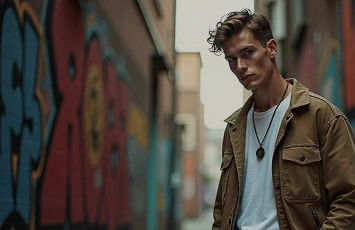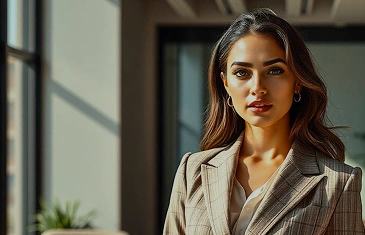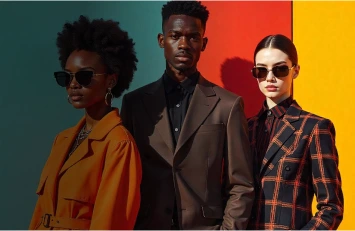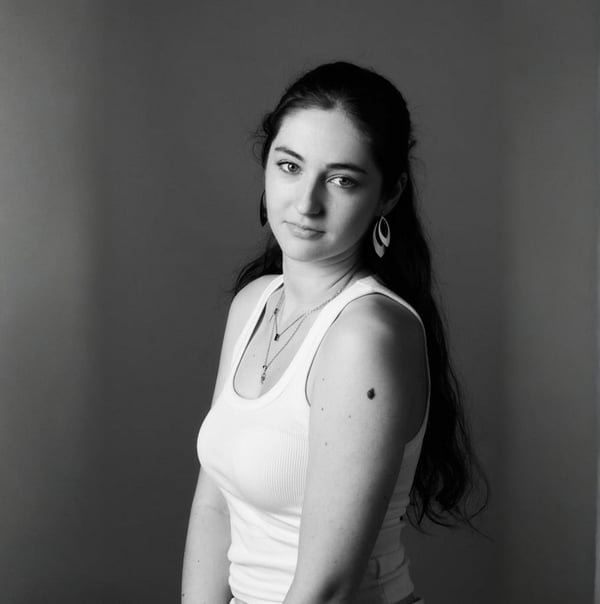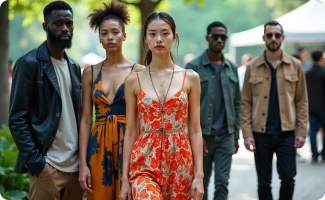
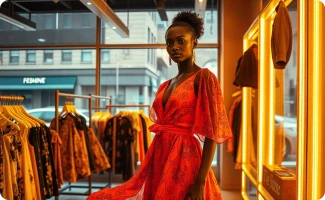
AI Moodboard Generator: Design Inspiration Made Easy
Table of Contents
- What Is an AI Moodboard Generator?
- How Does an AI Moodboard Generator Work?
- Benefits of Using an AI Moodboard Generator
- Applications in Fashion, Design, and Marketing
- Top Features of the Best AI Moodboard Generators
- Best AI Moodboard Generators to Try
- Modelia AI Moodboard Generator
- Future of AI Moodboard Design
- Conclusion
- FAQ: AI Moodboard Generator
Traditionally, building a moodboard was a time-consuming task, you had to search for photos, save and crop them, arrange them manually on digital software or even print and cut images for a physical board. This process, while valuable, often limited how quickly ideas could move from imagination to presentation but, with the arrival of AI moodboard generator, that workflow has completely changed. Now, in just a few minutes, you can transform abstract concepts into polished boards created to inspire.
Moodboards have always been at the center of the creative process. For decades, designers, artists and marketing teams have used them as a way to collect inspiration, define a style and communicate ideas visually. A good moodboard can set the tone for an entire collection, campaign or project. It brings together colors, textures, and imagery to tell a story without words.

What Is an AI Moodboard Generator?
An AI moodboard generator is essentially a digital assistant that uses artificial intelligence to help you create visual compositions. Instead of manually collecting and arranging images, the tool processes your input, whether that’s a keyword like “minimalist fashion”, a theme such as “spring color palette” or even a reference image, and generates a moodboard automatically.
Unlike simple collage apps AI tools go beyond arranging visuals randomly. They analyze aesthetic relationships between colors, shapes and styles, ensuring the final result looks cohesive and intentional. This makes the process not only faster but also more inspiring, because AI often surfaces unexpected visuals that can spark new creative directions.

How Does an AI Moodboard Generator Work?
The process of using an AI mood board generator is simple. It generally begins by defining your idea. You can start with a set of keywords that describe what you want to achieve, such as "futuristic streetwear" or "Scandinavian interiors". Once you enter your concept, the AI begins searching for relevant images from databases or generating them directly with AI image models.
The next step is creating the design. Here, the system arranges the selected images into a harmonious grid or composition. What would normally take hours of resizing, dragging and arranging is done in seconds. Many platforms allow you to refine the board by adding your own images, adjusting the placement, or modifying the color palette. Once the board is complete, you can export it in high resolution and share it directly with collaborators or clients. The process condenses hours of effort into a seamless, automated workflow.
Benefits of Using an AI Moodboard Generator
The biggest benefit of using AI for moodboard creation is speed. A task that used to take hours of manual searching and arranging can now be completed in minutes. This frees up more time for actual creative thinking instead of repetitive tasks. But speed is only one part of the equation. AI also ensures consistency, as it automatically organizes images in a way that feels aesthetically balanced. This is especially useful when you need to present professional results to clients or stakeholders.
Another important advantage is inspiration. Because AI can analyze vast datasets and propose visuals that you may not have found yourself, it often brings a fresh perspective. Designers report that AI moodboards sometimes reveal unexpected color combinations, unusual textures, or styles they had not initially considered. Finally, collaboration is made easier. Since most AI moodboard generators are online tools, sharing and co-creating in real time becomes effortless, which is essential for global teams working remotely.
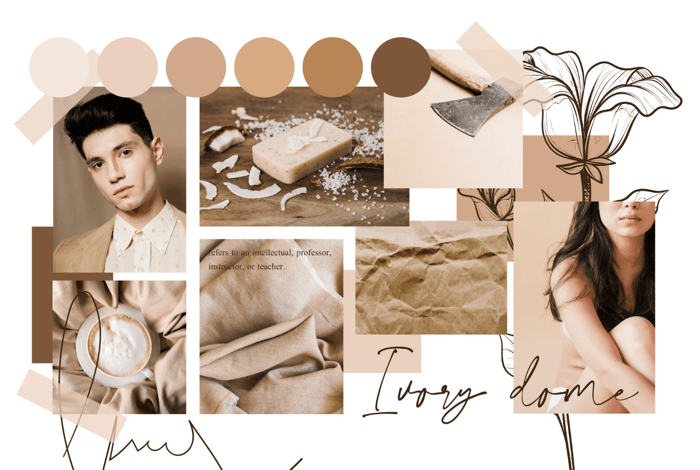
Applications in Fashion, Design, and Marketing
The applications of AI moodboard generators go far beyond just creative brainstorming. In fashion design, they are used to plan seasonal collections, experiment with silhouettes or define the mood of a runway presentation. Every creative idea in fashion needs a moodboard. Instead of manually cutting fabric samples or drawing inspiration boards, designers can create digital moodboards that reflect entire collections in minutes.
In graphic design, AI moodboards are often used to establish the visual identity of a brand or campaign. A moodboard can align typography, photography style and color palettes, ensuring everyone on the team has a shared vision. Interior designers use them to show clients how different textures and colors might look in a room before any real changes are made. Marketing teams use them to develop campaign visuals that align with brand identity, while content creators use AI powered boards to set the aesthetic tone of their social media feeds. The versatility of these tools makes them valuable across industries.
Top Features of the Best AI Moodboard Generators
When evaluating AI moodboard generators, several features set the best ones apart. The first is keyword-based generation. This allows users to start with just a concept in words and instantly see it transformed into a collection of visuals. Another crucial feature is smart layout automation. Rather than simply placing images next to each other, AI arranges them in a way that looks balanced and professionally designed.
Color palette extraction is another powerful feature. AI can automatically detect and highlight dominant colors in an image or theme, ensuring the final moodboard is consistent. Integration with popular design tools like Photoshop, Figma, or Canva is also valuable, as it allows creators to move seamlessly between inspiration and production. Finally, real-time collaboration is increasingly important, since teams often need to build and edit boards together across different locations.
Best AI Moodboard Generators to Try
There are many AI moodboard generators on the market, each catering to slightly different audiences. Milanote is widely used among creative professionals thanks to its flexibility and wide range of applications. Canva AI has become a favorite for marketing teams and beginners because of its user-friendly interface and strong collaboration tools. Fotor AI Moodboard is great for quick inspiration and simple boards without a steep learning curve.
Pinterest has also introduced AI driven features that automatically group and suggest images, making it easier to discover and build moodboards from millions of visuals.
Modelia AI Moodboard Generator
At Modelia, we designed our AI technology to support fashion professionals who need high-quality visuals without long production times. With our tools, you can instantly generate AI models wearing different outfits, making it easy to test looks, explore styling ideas or visualize how collections will appear on diverse body types. This eliminates the need for costly photo shoots in the early stages of design or marketing.
What makes Modelia especially powerful is that it goes beyond static visuals. You can experiment with variations of garments, mix and match outfits, and quickly create professional images that are ready for e-commerce, lookbooks or social media campaigns. By streamlining this process, Modelia helps brands present their collections faster while staying visually consistent and creatively flexible. For fashion companies aiming to innovate while saving time and resources, this tool is a true game changer.
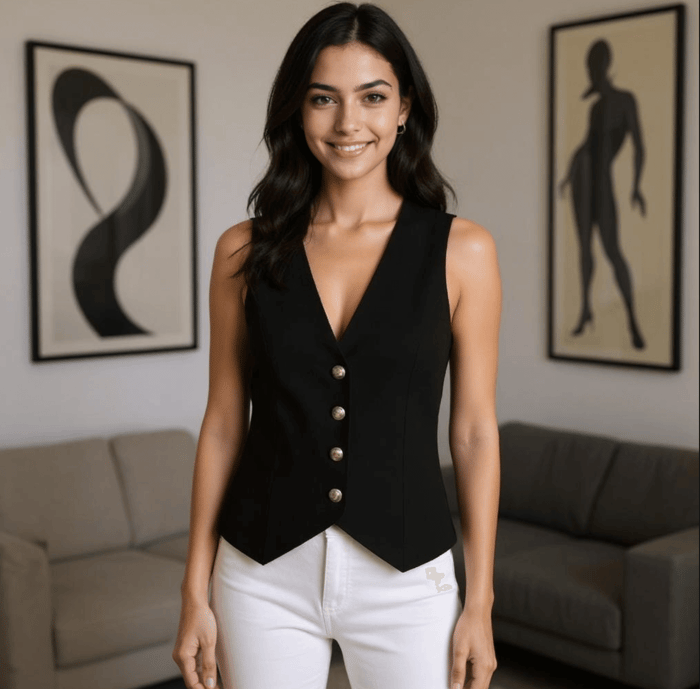
Future of AI Moodboard Design
The future of AI in moodboard creation is highly promising. We can expect to see dynamic boards that update in real time with the latest trends, giving brands an edge in staying relevant. Integration with 3D and augmented reality will allow designers to move beyond static images and explore immersive environments. Personalized curation will also become more advanced, with AI learning a designer’s preferences over time and proposing moodboards that reflect their unique style.
Collaboration will likely move into virtual spaces, where teams from around the world can work on the same board in real time as if they were in the same studio. As these technologies evolve, moodboard creation will no longer just be about inspiration, it will be about creating interactive experiences that connect ideas, people, and technologies in entirely new ways.
Conclusion
An AI moodboard generator is not just a productivity tool, it’s an inspiration engine. It shortens the gap between ideas and execution, turning abstract concepts into concrete visual directions in minutes. For designers, marketers, and creatives of all kinds, it removes repetitive tasks and gives more room to focus on originality.
With platforms like Modelia, creating moodboards is no longer a slow process, it’s fast, dynamic, and deeply connected to the needs of modern industries. Whether you are working on your next fashion collection, planning a marketing campaign, or simply looking for inspiration, AI moodboard generators can take your creative process to the next level.
Start exploring your ideas with AI and see how quickly you can bring your vision to life.
FAQ: AI Moodboard Generator
What is an AI moodboard generator?
An AI moodboard generator is a tool that uses artificial intelligence to create visual inspiration boards by automatically curating images, colors and design elements based on a theme or input.
How does an AI moodboard generator work?
It analyzes keywords, styles, or uploaded images and then compiles relevant visuals into a cohesive moodboard, saving time compared to manual curation.
Who can benefit from using an AI moodboard generator?
Designers, marketers, fashion brands, and creative professionals can use it to brainstorm ideas, present concepts, and align teams around a visual direction quickly.
What are the benefits of using AI moodboard generators?
They speed up the creative process, ensure visual consistency, provide instant inspiration, and allow easy customization to match specific brand aesthetics or project needs.
How would you rate this article:
Related Articles
- Influencer Marketing for Small Business: Step by Step Guide
- 7 Best fashion AI tools for designers
- The Most Followed Virtual Influencers in 2025
- Botika.io Pricing, Plans and Feature Breakdown
- Best AI Clothing Models for your Website Store
- 5 AI Fashion Design Tools for Modern Fashion Designers
- The Ultimate Guide to Upscaling Images Using AI Technology
- AI Agent for Fashion: Smarter Business & Design Tools
- 5 Free AI Face Swapping Online - Best Tools
- Modelia vs Botika: A Detailed Comparison for Ecommerce Businesses

